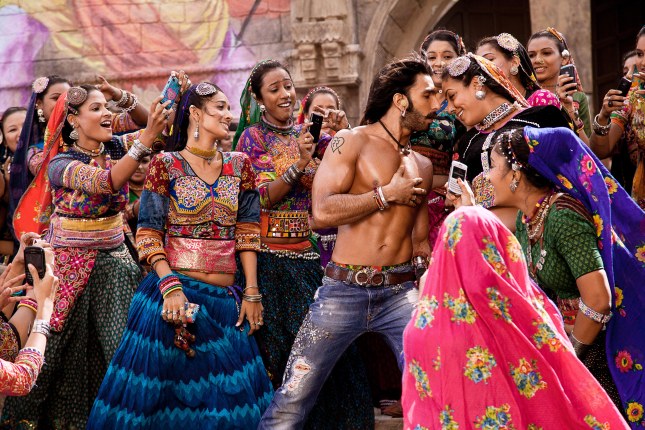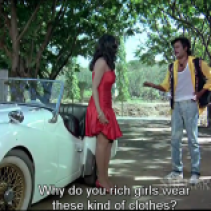Selvaraghavan can always be counted on to take a different approach, and this time he heads into fantasy for a tale of love so great that it could transcend worlds. It all sounds fine, inspirational maybe; except that the love between the characters never feels passionate enough to even inspire a short trip across town, let alone across worlds. The execution of the story is also clumsy with the action jumping between two love stories without any apparent commonality, except that Arya and Anushka are the two actors in both cases. Irandam Ulagam is disappointing on many levels; even more so because there are flashes of a good story, some engaging ideas and even a few entertaining moments hidden among all the dreary dialogues. And as if that wasn’t enough, seriously, how is it even possible to make Arya look this bad?
In this world there is the romance between Madhu Balakrishna (Arya) and Ramya (Anushka). Initially it’s a one-sided affair as Ramya feels that in Madhu she has found her Mr Right, but doesn’t know how to approach him. And then when Ramya does finally ask Madhu to marry her and is gently refused, she immediately decides instead to marry the man her parents have selected. Presumably because giving Madhu a chance to recover from the surprise proposal and perhaps give him time to find out something about her would be too much to expect! Madhu does however eventually fall in love with Ramya, and follows her to a medical camp to try and win her back before her wedding takes place. After building Madhu up as a wonderfully caring man who looks after his disabled father (one of the best scenes in the film), Selva doesn’t seem to find anything odd in the concept that Madhu would recklessly dump his family responsibilities and job as a lecturer to follow a woman who blows hot and cold and generally doesn’t seem to have any idea what she wants from him. Ramya is tedious in her indecisiveness and by the time the lifeless romance does manage to reach some form of conclusion it’s hard to care in any way about either Ramya or Madhu.
In the other world Varna (Anushka again) is a Xena kind of gal, who can swing a sword and take care of herself in a society where woman are definitely second class citizens. Here Arya is Maruvan, a drunken buffoon who wants to fight in his father’s army, but is woefully inept even when sober. Inexplicably he decides that Varna is the woman for him and after some heroic action does finally manage to win her as his wife. Except that it’s not the idyll he was perhaps expecting but is more a constant combat as Varna can’t stand him. So not much love there either. Not really looking good for a story all about grand passion that can span the stars.
Both characters played by Arya are wishy-washy with few redeeming features. Although Madhu is a kind-hearted man, he’s rather dull and has no chemistry whatsoever with his co-star. Maruvan seems to have been based on Shrek, which at least suits the fairy-tale landscape, but his transition from drunken village idiot to invincible warrior is just a little too instantaneous to be believable.
Anushka gets a better deal with Varna who at least has some personality, but Ramya is another weak character. There is nothing endearing about Ramya to explain why Madhu would sacrifice everything to be with her, and nothing about their love story which suggests passion or grand desire. And that’s the problem. To believe in a love so great that it transcends everything there needs to be evidence of that love – and it just isn’t here.
The soundtrack by Harris Jayaraj is excellent, but the songs are completely out of place and don’t seem to fit the narrative, although that may be due to the rather woeful picturisation. There are however a few moments where the choreography is different enough to almost work, if there were just a few more steps and a little less awkward shuffling. Even the background score by Anirudh Ravichander is a disappointment as it’s frequently loud and intrusive, and doesn’t seem to suit the storyline particularly well either.
The special effects are fine, although nothing too spectacular. They do create a different world, and the creatures such as the amazing ‘lion’ produce a fairy-tale atmosphere, enhanced by the fantastical fighting skills of our hero. However I did keep thinking that if those planetary bodies were really that close in the sky then the gravitational field would have been completely different – which was a little distracting at times.
Irandam Ulagam needs a passionate and believable romance to make Selvaraghavan’s concept of true love convincing, but the lack of chemistry and any emotion between the main characters results in a failure to bring the idea to life. Considering that Selva’s last film Mayakkam Enna was laden with emotional drama and desire, it’s strange that he seems to have missed out on this crucial ingredient here. The story has the potential to offer more and the concept of a world without love is intriguing, but there is nothing to draw you in and generate interest in the characters. Even the performances by two normally engaging actors are laboured and unappealing. The only thing I can recommend is the soundtrack, otherwise sadly I have to put Irandam Ulagam down as a miss.


































